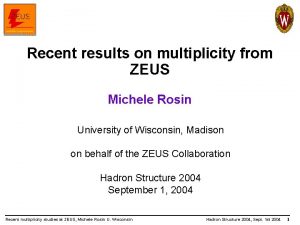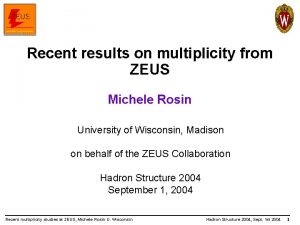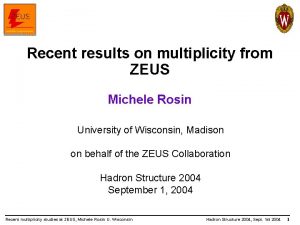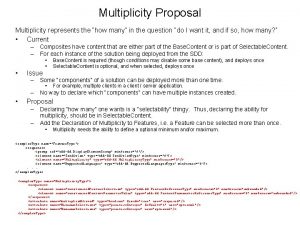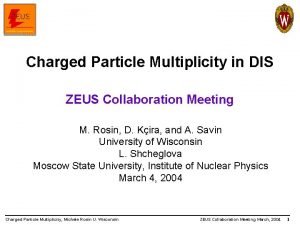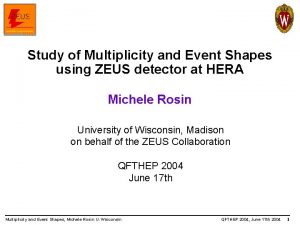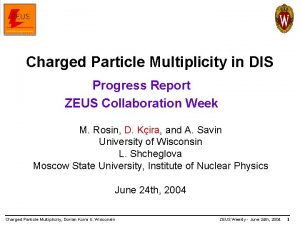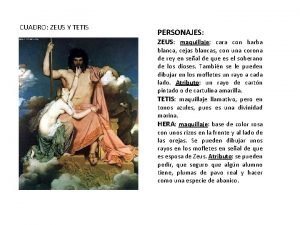Recent results on multiplicity from ZEUS Michele Rosin





















- Slides: 21

Recent results on multiplicity from ZEUS Michele Rosin University of Wisconsin, Madison Hadron Structure 2004 September 1, 2004 Multiplicity studies at HERA, Michele Rosin U. Wisconsin Hadron Structure 2004, Sept. 1 st 2004 1

HERA description & DIS kinematics • 920 Ge. V p+ (820 Ge. V before 1998) • 27. 5 Ge. V e- or e+ • 318 Ge. V cms (300 Ge. V) • Equivalent to a 50 Te. V Fixed Target DESY Hamburg, Germany H 1 ZEUS • DIS Kinematics: e(k) (q) e’(k’) remnant p(P) q’ Inelasticity 0 ≤ y ≤ 1 Multiplicity studies at HERA, Michele Rosin U. Wisconsin Virtuality of photon Fraction of p momentum carried by struck parton Hadron Structure 2004, Sept. 1 st 2004 2

e+e- & ep : Breit Frame Lab Frame DIS event · Breit Frame definition: · “Brick wall frame” incoming quark scatters off photon and returns along same axis. ·Current region of Breit Frame is analogous to e+e-. PT Multiplicity studies at HERA, Michele Rosin U. Wisconsin PL Hadron Structure 2004, Sept. 1 st 2004 3

Monte Carlo models: Parton cascades and hadronization Parton Shower Model: Models for parton cascades Color Dipole Model: · cascade of partons with decreasing virtuality continuing until a cut-off ~ 1 Ge. V 2 LEPTO HERWIG · Gluons are emitted from the color field between quark-antiquark pairs, supplemented with BGF processes. ARIADNE Hadronization models: Lund String Model: Cluster Fragmentation Model: between q and q moving apart, neighboring partons formed · color "string" stretched ·string breaks to form 2 color singlet strings, and so on until only on-mass-shell hadrons. LEPTO ARIADNE Multiplicity studies at HERA, Michele Rosin U. Wisconsin · color-singlet clusters of ·Clusters decay into hadrons HERWIG Hadron Structure 2004, Sept. 1 st 2004 4

Intro to LPHD · Local Parton Hadron Duality (LPHD): Cut off parton shower at mass of pion, distribution of final partons is same as final hadrons. · Attempt to check LPHD using Normalized Factorial Moments: (NFM) · Particle multiplicities are studied in terms of NFMs for a specified phase space region of size Ω. ·Compare data to MC with and without hadronization Multiplicity studies at HERA, Michele Rosin U. Wisconsin Hadron Structure 2004, Sept. 1 st 2004 5

Factorial Moments vs. p. T ·Multiplicity moments of order q=2, …, 5 in current region of Breit frame ·LHPD doesn’t describe our data in soft part of the spectrum ·Understanding hadronization is essential Multiplicity studies at HERA, Michele Rosin U. Wisconsin Hadron Structure 2004, Sept. 1 st 2004 6

Multiplicity in Current and Target regions of Breit Frame ·Measurement of multiplicities in Breit Frame vs. Q 2 ·Ratio of mean multiplicities in current and target regions vs. Q 2 show higher multiplicity in target region. Multiplicity studies at HERA, Michele Rosin U. Wisconsin Hadron Structure 2004, Sept. 1 st 2004 7

Measurement vs. Q · Consistent with e+e- data for high Q 2 ·Disagreement at low Q 2 may be attributed to gluon radiation ·Idea of current analysis: Understand current and target multiplicity and compare to e+e- Multiplicity studies at HERA, Michele Rosin U. Wisconsin Hadron Structure 2004, Sept. 1 st 2004 8

Multiplicity: ep vs. e+e- (1) current region of Breit frame for ep similar to one hemisphere of e+ e. Use Q as scale, multiply hadrons by 2 Where does other end of the string connect? Multiplicity studies at HERA, Michele Rosin U. Wisconsin Hadron Structure 2004, Sept. 1 st 2004 9

Multiplicity: ep vs. e+e- (2) ep hadronization compared to e+e-. ep: Split into Current and Target Region – one string two segments. Use invariant masses of the string (Lab) and segments (Breit). Breit Frame => Multiplicity studies at HERA, Michele Rosin U. Wisconsin Hadron Structure 2004, Sept. 1 st 2004 10

Gluon radiation, Q, and 2*EBreit Soft Contribution q Hard Contribution q q q g g QCD Compton ·In hard and soft processes gluon radiation occurs ·These gluons can migrate to target region ·Total energy in the current region of Breit frame and multiplicity are decreased due to these migrations (Q 2 is not) ·Effect is more pronounced for low Q 2 : more low energy gluons No migrations: Multiplicity studies at HERA, Michele Rosin U. Wisconsin With migrations: Hadron Structure 2004, Sept. 1 st 2004 11

Multiplicity vs. 2*Ebreit · Measure multiplicity dependence on 2*EBreit and compare to previous ZEUS measurement vs. Q, and to e+e·Points agree with the e+epoints ·This approximation of invariant mass partially takes into account the real distribution of the particles. ·Current region understoood, would like to use some energy scale ro compare target region for ep to e+e-. . Multiplicity studies at HERA, Michele Rosin U. Wisconsin Hadron Structure 2004, Sept. 1 st 2004 12

Multiplicity e+e- and pp e+ ee+e-: pp vs. √q 2 had pp vs. √spp pp Invariant mass of pp Multiplicity studies at HERA, Michele Rosin U. Wisconsin ·Agreement between e+eand pp plotted vs. pp invariant mass Hadron Structure 2004, Sept. 1 st 2004 13

Charged Hadrons & Effective Mass: experimental method ·Measure HFS within for best CTD acceptance ·Measure # charged tracks, reconstruct number of charged hadrons ·Measure invariant mass of the system (Meff) in corresponding delta eta region. ·Energy is measured in the CAL Study: <nch> vs. Meff CTD CAL within the CTD acceptance Multiplicity studies at HERA, Michele Rosin U. Wisconsin Hadron Structure 2004, Sept. 1 st 2004 14

The use of Meff as energy scale · For ep in lab frame, measure visible part of <nch> vs. visible part of energy available for hadronization: Meff Whad Meff Lab Frame Visible part ·Previously shown in e+e- and pp that the number of charged particles vs. invariant mass of the system is universal ·Based on previous studies in e+e-, one can assume that the visible part of the system behaves as the total, maybe excluding the remnants Meff: HFS measured in the detector where the tracking efficiency is maximized Multiplicity studies at HERA, Michele Rosin U. Wisconsin Hadron Structure 2004, Sept. 1 st 2004 15

Detector acceptances for current and target regions The visible part of the multiplicity is very different for the current and target region of the Breit Frame. Visible Part · 90% acceptance for current region · 29% for target region ·When comparing visible part of the current and target regions we compare total current region with only the part of the target region that is far from the proton remnant Proton remnant Multiplicity studies at HERA, Michele Rosin U. Wisconsin Hadron Structure 2004, Sept. 1 st 2004 16

Breit frame vs Meff ·Similar dependence observed in multiplicity for visible parts of current and target regions of the Breit frame as a function of their respective effective mass ·Target multiplicity is slightly higher than current multiplicity and combined current and target region shoe same behavior as target region ·Multiplicity and Meff are Lorentz invariant so can move to the lab frame Multiplicity studies at HERA, Michele Rosin U. Wisconsin Hadron Structure 2004, Sept. 1 st 2004 17

Lab Frame measurement ·Agreement between data and ARIADNE ·LEPTO also describes data but when including the soft color interactions LEPTO-SCI deviates from data Multiplicity studies at HERA, Michele Rosin U. Wisconsin Hadron Structure 2004, Sept. 1 st 2004 18

Lab frame: <nch> vs. Meff in x bins ·Would also like to study x and Q 2 dependence · x range split into similar bins as in previous multiplicity paper. · weak x dependence in both data and MC observed not sufficient to explain difference · Q 2 dependence? => next page Multiplicity studies at HERA, Michele Rosin U. Wisconsin Hadron Structure 2004, Sept. 1 st 2004 19

Lab frame: x and Q 2 bins · Data described by ARIADNE · LEPTO above data · No Q 2 dependence observed Multiplicity studies at HERA, Michele Rosin U. Wisconsin Hadron Structure 2004, Sept. 1 st 2004 20

Summary ·The hadronic final state has been investigated in DIS ep scattering in terms of the mean charged multiplicity and respective invariant mass of the charged and neutral particles, Meff ·Measurement in current region of the Breit frame show same dependence as e+e- if 2*Ecurrent is used as the scale ·Similar dependence observed in multiplicity for visible part of the current and target regions of the Breit frame as a function of their respective effective mass ·Lab frame measurements show no strong dependence on x or Q 2 ·Full comparison of current and target region is still underway, the main problem being that visible part of the target region is only 30% of the total, and MC studies expect that the multiplicity behavior changes when we go closer to the proton remnant. Multiplicity studies at HERA, Michele Rosin U. Wisconsin Hadron Structure 2004, Sept. 1 st 2004 21
 Michelle rosin
Michelle rosin Jamie rosin
Jamie rosin A friend emails you the results
A friend emails you the results How to skim passages
How to skim passages Geotaphonomy
Geotaphonomy Recent developments in object detection
Recent developments in object detection Recent amendments in companies act
Recent amendments in companies act Modern trends in project management
Modern trends in project management After miguel's recent automobile accident
After miguel's recent automobile accident Many recent college graduates have faced
Many recent college graduates have faced Recent trends in mis
Recent trends in mis Recent demographic changes in the uk
Recent demographic changes in the uk Recent trends in ic engine
Recent trends in ic engine Passive voice in news
Passive voice in news Recent advances in ceramics
Recent advances in ceramics Explain recent trends in india's foreign trade
Explain recent trends in india's foreign trade Comait
Comait Myipsclever
Myipsclever Recent developments in ict
Recent developments in ict Http drive google com
Http drive google com Micostate
Micostate Multiplicity pada class diagram
Multiplicity pada class diagram
